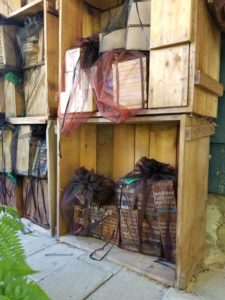In late July and August, the garden beckons us like no other time. Harvesting and cleaning and watering are just some of the daily tasks that ensure the garden is in good condition not only for this season, but next year. These tasks all come into focus when I receive my copy of Pome News a quarterly newsletter from the Oregon Orchard Society. Reminders of what to do are invaluable since quite a few of these tasks are forgotten or not completed.

The forgotten Saskatoon.
What I was most surprised about was the adding of fertilizer, like kelp, alfalfa meal or canola meal to ground covers. I have always thought of adding the fertilizer in the spring, but now I realize that maintaining plants and soil is a year-round task. Other general tasks include pruning flowering shrubs like azaleas and rhododendrons if needed. In the front of the house this one bramble has seemingly taken over part of the yard. I clipped it back so we could access the front yard. This summer, temperatures have been hot and the wild rose has been going berserk. One plant near the front steps was totally unruly and was thinking of taking over the front door. This rose does very well over an arbor, but space is limited now with other plants taking over the space. As I am cruising the front yard, I looked for a forgotten Saskatoon berry bush. I find it totally overgrown by vigorous Red Osier dogwood plant. No wonder I could not see it. The poor Saskatoon bush , it tried to produce a multitude of very thin branches, but leaves need the sun. The birds love this fruit, as I do, so I hope it will again blossom for us next spring.

Staking out tomato branches
Part of all this is to cruise around your garden to see what needs doing. For example, staking tomatoes is not something you do once a week or so, but gets done when it needs to be done. I saw a bumble bee flitting among the cherry tomato flowers today. Hoping for a good crop this year. It was Bombus mixtus– a mostly yellow bee with a very small area of orange on its ‘tail’.

Bee homes neatly netted for the summer months
On my travels through the garden, I pass by a space underneath my back verandah. This area is not in direct sun and is protected from the rain. Temperatures are about the same as shady areas in the garden. The reason I am going on about this space is that every year I use this space to store my mason bee homes with nests. This space is out of the way, and is not used for anything else. So the bees inside their cocoons remain save and sound until the fall.
It is important to keep the nests in a not too hot and not too cold area. Too hot, and the bees will be warm and use up all their winter and next spring’s fat reserve. The result in this case is that the bees do not have the energy to eat their way out of the cocoons. Too cold, and bees do not develop into their adult form inside a cocoon.
The timing for moving nests into a cooler place, under cover and inside wasp proof net bags is by late June, when bee flight has ceased. I take down all the bee homes and set them, 2 or 3 of them, inside a wasp-proof net bag. I find that by doing this, the level of parasitism is quite low. I remove the bee homes out of the net bags in October when I harvest and clean the nesting trays and the cocoons in readiness for next spring.
Another way of storing mason bee homes with filled nests is inside a shed that has a window. The window is an important part of how it works. and in this case, it is not necessary to place filled nests into a wasp proof bag. The window works like this. When the little parasitic wasps mature, they emerge from infested cocoons and go to the window. They die at the window trying to get out and do not seem to attack and parasitize more cocoons.
Either system of management takes care of these pesky little wasps that can devastate your bees. One of the reasons why these pesky little wasps can be so devastating is that once spring comes around and warm temperatures arrive in spring, they can reproduce every 3 weeks or so until late September. If one wasp lays 10 eggs, and these lay 10 eggs…… no wonder they can devastate your cocoon crop!

Destruction by mice

Mice like eating bee larvae!!
Other pesky pests are mice. Mice do not damage nesting trays whether made of wood or corn material. But nesting tubes made of cardboard are fair game from mice and other rodents. Mice listen to the sound of the developing bee larva feeding on their pollen and nectar lump. When they locate a larva, the mouse chews only to get access to the cocoons. It makes quite a pattern, but how it devastates your cocoons. If you are using cardboard tubes, place nesting cardboard tubes in a secure metal box so mice cannot get at your cocoons before harvest time. Keep your cocoons save and your pollination will be even better next spring. If the number of bee cocoons are not quite enough for next years spring pollination, let us know.
